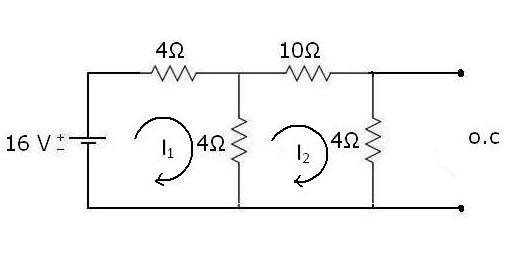Statement: In a linear network having number of voltage or current sources and
resistances, the current through any branch of the network is the algebraic sum of the
currents due to each of the sources when acting independently.
resistances, the current through any branch of the network is the algebraic sum of the
currents due to each of the sources when acting independently.
Three steps applying superposition principle:
Step 1: Turn on only one independent source and turn off all other independent sources. Find the output current or voltage for that source using KVL or KCL or other basic method.
Step 2: Do step 1 for all the independent source separately.
Step 3: Add all the contributions of independent sources algebraically and find total contribution.
The law of superposition theorem is only applicable for linear circuit. So apply this method in linear circuit.
LET US SOLVE A PROBLEM
Ques.) Find the current through 10 Ω resistance in the given network by using superposition theorem?
Solution:-For finding current through 10Ω resistance by usingsuperposition theorem, we follows same step as we discussed in previous post.
Activating ‘16V’ source at a time, other will be deactivated.

After deactivation of ‘16A’ current source, two individual box are seem clearly in which we can easily applying mesh analysis for finding current through 10Ω resistance when ‘16V’ voltage source is active. You can also use nodal analysis or ohm’s law with current division rule.

After deactivation of ‘16A’ current source, two individual box are seem clearly in which we can easily applying mesh analysis for finding current through 10Ω resistance when ‘16V’ voltage source is active. You can also use nodal analysis or ohm’s law with current division rule.
I am not going to discussed how to solve a circuit through mesh analysis which I already discussed. If you want to know How to solve a circuit through mesh analysis, click here.
{Hints: - Equations are,
-8I1+4I2=-16 ··············· (1)
4I1-18I2=0 ··············· (2) }
So, after solving this circuit, we get
So, after solving this circuit, we get
I1 = 2.25A & I2 = 0.5A
Then, I10Ω = I2 = 0.5A
Activating ‘16A’ source at a time, other will be deactivated.
After deactivation of ‘16V’ voltage source, we can one step reduced circuit and applying current division rule. By applying current division rule, we can easily find the value of current in 10Ω resistance.
After deactivation of ‘16V’ voltage source, we can one step reduced circuit and applying current division rule. By applying current division rule, we can easily find the value of current in 10Ω resistance.
I1 = 4A
I2 = 12A
So, I10Ω = I1 = 4A
Now, final circuit is in which all the source will be activated. Direction of current when single source is active and other is deactivated through 10Ω resistance will be shown with their value, as shown below
At last, the current through 10Ω resistance is 3.5A and greater current has their direction as shown below.
Answer: - I10Ω = 3.5A






No comments:
Post a Comment